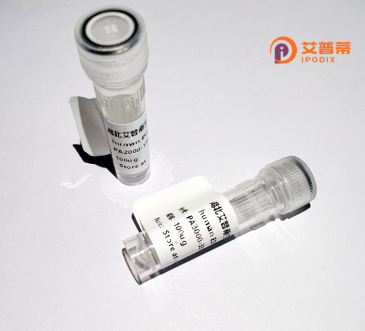
| 纯度 | >97%SDS-PAGE. |
| 种属 | Human |
| 靶点 | ROBO4 |
| Uniprot No | Q8WZ75-1 |
| 内毒素 | < 0.01EU/μg |
| 表达宿主 | E.coli |
| 表达区间 | 1-469aa |
| 氨基酸序列 | MGSGGDSLLG GRGSLPLLLL LIMGGMAQDS PPQILVHPQD QLFQGPGPAR MSCQASGQPP PTIRWLLNGQ PLSMVPPDPH HLLPDGTLLL LQPPARGHAH DGQALSTDLG VYTCEASNRL GTAVSRGARL SVAVLREDFQ IQPRDMVAVV GEQFTLECGP PWGHPEPTVS WWKDGKPLAL QPGRHTVSGG SLLMARAEKS DEGTYMCVAT NSAGHRESRA ARVSIQEPQD YTEPVELLAV RIQLENVTLL NPDPAEGPKP RPAVWLSWKV SGPAAPAQSY TALFRTQTAP GGQGAPWAEE LLAGWQSAEL GGLHWGQDYE FKVRPSSGRA RGPDSNVLLL RLPEKVPSAP PQEVTLKPGN GTVFVSWVPP PAENHNGIIR GYQVWSLGNT SLPPANWTVV GEQTQLEIAT HMPGSYCVQV AAVTGAGAGE PSRPVCLLLE QAMERATQEP SEHGPWTLEQ LRATLKRPE |
| 预测分子量 | 49 kDa |
| 蛋白标签 | His tag N-Terminus |
| 缓冲液 | PBS, pH7.4, containing 0.01% SKL, 1mM DTT, 5% Trehalose and Proclin300. |
| 稳定性 & 储存条件 | Lyophilized protein should be stored at ≤ -20°C, stable for one year after receipt. Reconstituted protein solution can be stored at 2-8°C for 2-7 days. Aliquots of reconstituted samples are stable at ≤ -20°C for 3 months. |
| 复溶 | Always centrifuge tubes before opening.Do not mix by vortex or pipetting. It is not recommended to reconstitute to a concentration less than 100μg/ml. Dissolve the lyophilized protein in distilled water. Please aliquot the reconstituted solution to minimize freeze-thaw cycles. |
以下是关于ROBO4重组蛋白的3篇参考文献及其摘要概括:
---
1. **文献名称**:*"ROBO4: A novel endothelial cell receptor mediating anti-angiogenic effects"*
**作者**:Jones et al.
**摘要**:该研究发现ROBO4重组蛋白通过拮抗VEGF信号通路抑制血管内皮细胞的迁移和血管生成,揭示了其在病理性血管疾病(如肿瘤和视网膜病变)中的潜在治疗作用。
---
2. **文献名称**:*"SLIT2/ROBO4 signaling pathway modulates endothelial barrier function via RhoA activation"*
**作者**:Koch et al.
**摘要**:研究证实ROBO4重组蛋白与配体SLIT2结合后,通过调控RhoA GTP酶活性增强血管内皮屏障完整性,减少炎症或缺血诱导的血管渗漏,为治疗血管通透性疾病提供机制依据。
---
3. **文献名称**:*"Recombinant ROBO4 protein attenuates tumor angiogenesis by stabilizing endothelial junctions"*
**作者**:Zhang et al.
**摘要**:实验表明,外源性ROBO4重组蛋白通过激活Wnt/β-catenin通路促进内皮细胞间连接蛋白表达,抑制肿瘤血管异常生长,并增强化疗药物在肿瘤组织中的递送效率。
---
以上研究均聚焦于ROBO4重组蛋白在血管生物学中的功能机制及治疗潜力,涵盖抗血管生成、屏障调控和肿瘤治疗等领域。
**Background of ROBO4 Recombinant Protein**
ROBO4. also known as Roundabout homolog 4. is a transmembrane receptor belonging to the Roundabout (ROBO) family, which is evolutionarily conserved and primarily involved in cellular guidance mechanisms. Unlike other ROBO family members (ROBO1-3) that are widely studied in neuronal development, ROBO4 is predominantly expressed in vascular endothelial cells and plays a critical role in regulating angiogenesis and vascular stability. It was initially identified for its role in inhibiting endothelial cell migration and tube formation, thereby modulating blood vessel growth and patterning.
Structurally, ROBO4 contains immunoglobulin (Ig)-like and fibronectin type III (FN3) domains in its extracellular region, which mediate ligand interactions, and a cytoplasmic domain responsible for intracellular signaling. ROBO4 interacts with its ligand SLIT2. though recent studies suggest it may also signal through SLIT-independent pathways, involving cross-talk with other receptors like vascular endothelial growth factor receptor 2 (VEGFR2). This interaction influences pathways such as SRC kinase and small GTPases (e.g., RAC1), crucial for cytoskeletal dynamics and endothelial barrier function.
In pathological contexts, ROBO4 is implicated in diseases characterized by abnormal angiogenesis, including cancer, diabetic retinopathy, and atherosclerosis. Its dual role—promoting vascular quiescence in mature vessels while restricting excessive sprouting in developing ones—makes it a potential therapeutic target. For instance, ROBO4 overexpression has been shown to inhibit tumor angiogenesis, whereas its loss exacerbates vascular leakage in inflammatory conditions.
ROBO4 recombinant protein, produced via mammalian or insect cell systems, retains the functional domains necessary for receptor-ligand binding and signaling studies. It is widely used in *in vitro* assays to investigate endothelial cell behavior, vascular permeability, and angiogenesis mechanisms. Additionally, it holds promise as a therapeutic agent or biomarker for vascular-related disorders, underscoring its translational relevance in biomedical research.
×